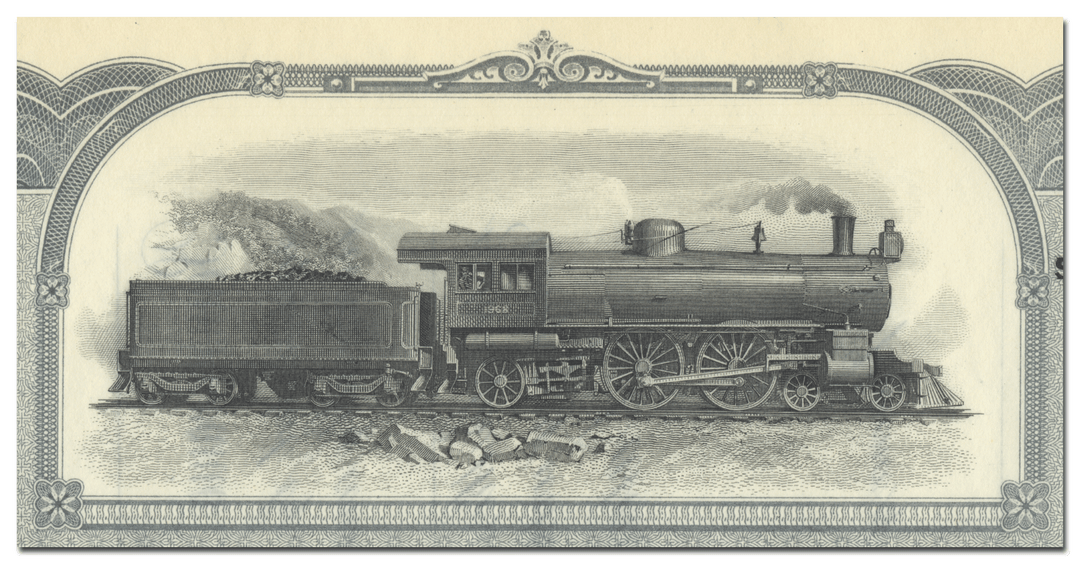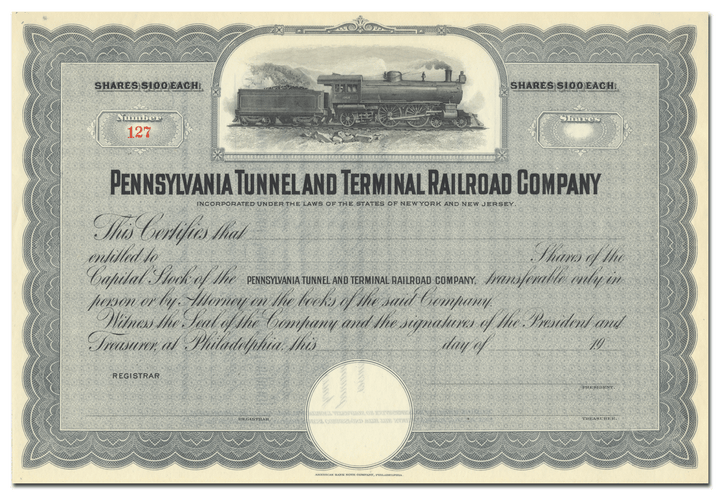Pennsylvania Tunnel and Terminal Railroad Company
- Guaranteed authentic document
- Orders over $75 ship FREE to U. S. addresses
Product Details
| Company | Pennsylvania Tunnel and Terminal Railroad Company |
| Certificate Type | Capital Stock |
| Date Issued | Unissued, circa early 1900's |
| Canceled | No |
| Printer | American Bank Note Company |
| Signatures | NA |
| Approximate Size |
12" (w) by 8" (h) |
|
Product Images |
Representative of the piece you will receive |
| Authentic | Yes |
| Additional Details | NA |
| Value Reference |
Historical Context
Various plans to cross the Hudson River were discussed as early as the 1870s, and both tunnel and bridge projects were considered by the railroads and government officials. A tunnel project for the Hudson and Manhattan Railroad (H&M), a rapid transit line, began in 1874, and encountered serious engineering, financial and legal obstacles. The project was halted in 1880 after a blowout accident that cost 20 lives. Work on the H&M project, known as the Uptown Hudson Tubes, continued intermittently but was not completed until 1908.
The technology of tunnel-building was still primitive and risky in the 1880s, and this gave impetus to a major bridge design proposal promoted by engineer Gustav Lindenthal. The bridge would be situated between Hoboken, New Jersey and 23rd Street in Manhattan. However, due to the congested shipping conditions in New York Harbor, the design called for an enormous bridge span that would have been twice that of the Brooklyn Bridge. Although Congress granted Lindenthal's company a charter in 1890 for construction of a bridge, the huge $27 million project cost would have to be shared by several railroads. The Panic of 1893 made large capital investments nearly impossible for some time, as one third of the nation's railroads failed. Some foundation masonry was laid on the Hoboken side in 1895, but the Pennsylvania Railroad was unsuccessful in getting other companies to share in the expenses, and the bridge project was abandoned.
Revised Plans
The PRR, working with the Long Island Railroad, developed several new proposals for improved regional rail access in 1892. They included construction of new tunnels between Jersey City and Manhattan, and possibly a tunnel to Brooklyn; new terminals in mid-town Manhattan for both the PRR and LIRR, completion of the Hudson Tubes, and a bridge proposal. These ideas were discussed extensively for several years but did not come to fruition until the turn of the century. In 1901 the PRR took great interest in a new railroad approach just completed in Paris, France, whereby electric locomotives were substituted for steam locomotives prior to the final approach to the city. This technique enhanced the prospects for building a tunnel under the Hudson. Additionally, the PRR made plans to acquire majority control of the LIRR, so that one new terminal could be built in Manhattan, rather than two.
The PRR created subsidiaries to manage the project. The Pennsylvania, New Jersey and New York Railroad and the Pennsylvania, New York and Long Island Rail Road, were the New Jersey and New York parts, respectively. The PNJ&NY was incorporated February 13, 1902, and the PNY&LI was incorporated April 21, 1902. They were consolidated into the Pennsylvania Tunnel and Terminal Railroad (PT&T) on June 26, 1907.
Design and Construction
The design and construction aspects of the project were organized into three principal divisions.
Meadows Division
The original PRR route in New Jersey ran to the Exchange Place ferry terminal in Jersey City. The Meadows Division project built a new route from the PRR main line at Harrison, New Jersey, northeast to the west end of the new tunnels. This involved constructing a new station at Harrison, Manhattan Transfer, along with a rail yard, to provide for changing between steam and electric locomotives. Northeast from this new station the double track line was built on embankment through the Hackensack Meadowlands to the west portal of the tunnels under Bergen Hill in the Palisades
North River Division
The North River Division ran from the west portal of the tunnels to Manhattan. The PRR ultimately decided to build a pair of single-track tunnels under the river, called the North River Tunnels, between Weehawken and mid-town Manhattan; the two tunnels continued seamlessly west from Weehawken to the west portals. In later years "North River Tunnels" came to refer to the whole length of tunnel from the Bergen Hill, or western, portal in North Bergen to 10th Ave in Manhattan. Construction began in 1904 and the tunnels opened in 1910. Penn Station in Manhattan was also completed in 1910 and service from New Jersey to Manhattan began on November 27, 1910.
East River Division
The East River Division managed construction of tunnels running across Manhattan, and under the East River to a new coach yard in Queens. The East River Tunnels are four single-track tunnels that extend from the eastern end of Pennsylvania Station and cross the East River to Sunnyside Yard. Construction proceeded concurrently with the North River tunnels, and the tunnels opened in 1910. LIRR service to Penn Station began on September 8, 1910.
Related Collections
Additional Information
Certificates carry no value on any of today's financial indexes and no transfer of ownership is implied. All items offered are collectible in nature only. So, you can frame them, but you can't cash them in!
All of our pieces are original - we do not sell reproductions. If you ever find out that one of our pieces is not authentic, you may return it for a full refund of the purchase price and any associated shipping charges.









